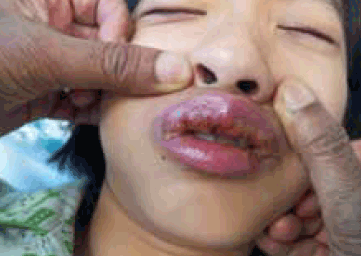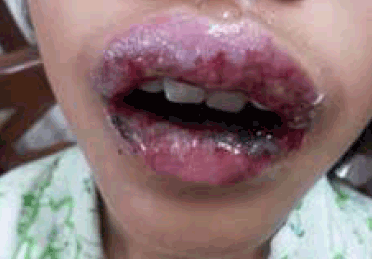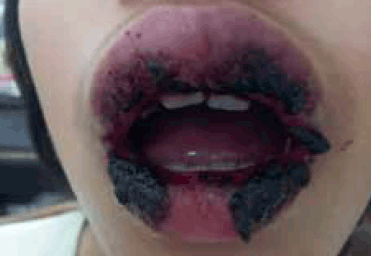
Figure 1. Extensive irregular border, ‘non-cluster’ lip ulcers
Question 1
What are the differential diagnoses?
Question 2
What is the most likely diagnosis?
Question 3
Would you admit this patient to hospital?
Answer 1
Differential diagnoses include a drug reaction to carbamazepine; acute herpetic gingivo stomatitis; herpangina; hand, foot and mouth disease (HFMD); and aphthous stomatis.
Answer 2
The most likely diagnosis is an adverse drug reaction to carbamazepine. This is based on the presence of a temporal relationship between drug intake and onset of the disease, clinical appearance and distribution of the lesion, and exclusion of other ulcerative lesions.
The possibility of other aetiologies can be excluded for the following reasons:
- Acute herpetic gingivo stomatitis: herpetic lesions can occur anywhere in the oral cavity. They are smaller, have regular borders and tend to be in clusters. The lesions start with grouped vesicles or ulcers on an erythematous base. Jane’s ulcers were ‘non-cluster’ in appearance. They began with irregular cracking, fissuring and, later, bloody crusting of the lips.
- Herpangina: these ulcers are generally 1–2 mm (<5 mm) in diameter and few in number (range 2–12). The distribution is most commonly at the back of the mouth and throat, for example, on the soft palate, tonsils and uvula.
- HFMD: there were no lesions on her hands or feet. About 75% of children with HFMD develop skin lesions on the palms and soles. Further, in HFMD, the ulcers tend to be inside the mouth rather than on the lips. The distribution is most commonly at the front of the mouth.
- Aphthous stomatitis: these are usually small discrete painful ulcers surrounded by an erythematous halo. The ulcers are punched-out and covered with a yellow-grey fibrinous membrane.
Answer 3
Jane should be admitted to hospital as she was unwell, had a high fever, poor oral intake and needed to be rehydrated. She needs to be specifically monitored for any possibility of Steven Johnson Syndrome (SJS) or toxic epidermal necrolysis (TEN), which is a potentially fatal condition secondary to an adverse reaction to carbamazepine.
Case continued
Jane was admitted to hospital 5 days after developing the fever and was immediately rehydrated with intravenous normal saline. She was also given intravenous amoxicillin, clavulanic acid and oral acyclovir. Carbamazepine was stopped. Her fever settled within 24 hour after admission. However, the ulcers progressed to pan-mucositis of her mouth and throat (Figure 2). Subsequent serological testing for Herpes simplex and Mycoplasma pneumoniae were negative. Jane recovered over the following 6 days (Figures 3, 4).

Figure 2. Progression to pan-mucositis of her mouth and throat

Figure 3. Typical bloody crusting of the lips

Figure 4. Full recovery 6 days after admission
Question 4
What is the final diagnosis?
Question 5
Should this patient be rechallenged with carbamazepine in the future?
Answer 4
The final diagnosis is erythema multiforme (oral variant) or drug-induced oral erythema multiforme. This patient presented with ulcerations of the mouth and lips, which are typical of erythema multiforme without any skin target lesion. This is a third category of erythema multiforme, which is rare and less recognised.1 The typical target lesions may appear during subsequent recurrence.2
Answer 5
This patient should not be given carbamazepine in future as subsequent attacks can produce more severe forms of erythema multiforme involving the skin.1 It is important to note that there is a possible cross-sensitivity between carbamazepine, phenobarbitone and phenytoin. Hence, these three anticonvulsants should be avoided in this patient.3,4 Alternative antiepileptics to consider for this patient include levitiracetam or sodium valproate.
A recent systematic review confirms that there is a strong association between the HLA-B*1502 allele and carbamazepine-induced SJS and TEN in Han-Chinese, Thai and Malaysian populations.5
In December 2007, the United States Food and Drug Administration recommended HLA-B*1502 genotyping for all Asians prior to the use of carbamazepine. HLA testing was made mandatory in Hong Kong and Taiwan following this recommendation. This practice has been the standard of care in Singapore since April 2013.6 This recommendation applies to Jane, a Malaysian Chinese woman.
Key points
- Erythema multiforme can present as a single mucosal oral lesion without skin target lesions.
- Important clinical features of oral erythema multiforme include positive drug history, sudden onset, extensive ulcerations of the oral cavity and cracking and fissuring of lips with bloody crusting.
- All patients started on carbamazepine should be warned about possible drug reactions and to stop the drug immediately if there is any fever, oral ulcers or skin rash.
- It is important to identify and distinguish oral erythema multiforme from other ulcerative disorders involving the oral cavity for early management because subsequent attacks can produce more severe forms of erythema multiforme involving the skin.
Competing interests: None.
Provenance and peer review: Not commissioned; externally peer reviewed.